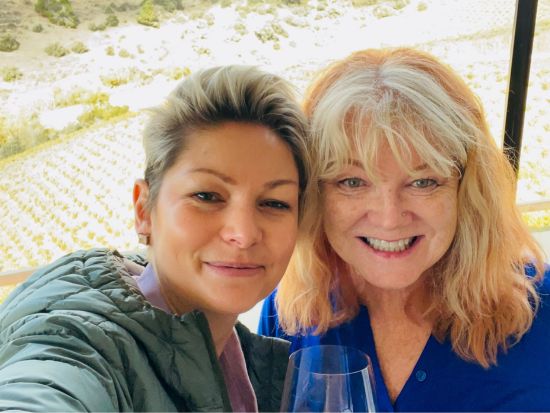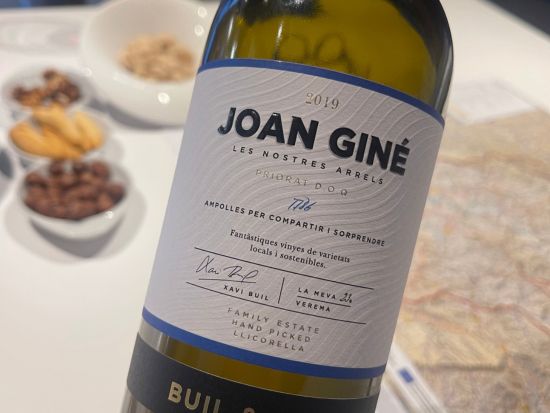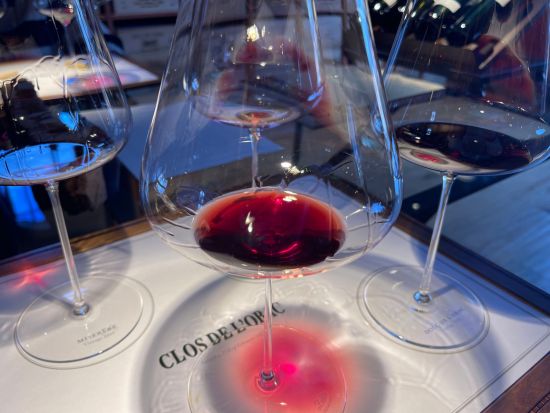
What’s the deal with Priorat you are asking?
Priorat is one of Catalunya’s 12 Denominaciones de Origen and holds “DO+” status, similar to DOCa Rioja. Referred to as Denominació d’Origen Qualificada (DOQ) in Catalan, it imposes stricter rules. These include bottling wines within the region, mandating wineries to precisely outline the vineyards used for DOCa/DOQ wines, and enforcing stringent quality controls across vintages.
Priorat, a region renowned for its breathtakingly steep slopes and the birthplace of Spain’s most exquisite wines. Here, meandering roads lead to charming hilltop villages overlooking small vineyard plots mainly planted with Garnacha and Cariñena vines. Crafting wine in this rugged terrain is no easy task, yet the continuous dedication of winemakers battling the challenging slopes and climate yields nothing short of extraordinary results.
A distinguishing feature of Priorat, setting it apart from other wine regions, is its renowned Llicorella soil, characterized by crumbling black slate and quartz. This nutrient-poor environment compels grapevines to delve deep for sustenance, resulting in Priorat wines’ distinctive mineral concentration, a hallmark of their unique character.
Once celebrated for robust, powerhouse reds that earned critical acclaim, the Priorat has evolved to something elegant, which is something that I learned a while back at a Wine tasting with Dominik from Terroir Al Limit. That night I had no doubt in my mind that these are the new faces of Priorat Wines and I needed to know more.
While maintaining its legacy, the region now harmonizes those full-bodied reds with wines seeking to express the terroir in a mineral-infused, elegant fashion.
Needless to say I missioned off on my second trip to Priorat not long after tasting the wines of Terroir Al Limit. Both my previous trips had been to visit the Village of Scale Dei. My first Priorat Winery ever visited was La Conreria d’ Scala Dei, where I remember tasting their Garnacha Blanca, Les Brugueres.

It retails for around €21.50 and it made a lasting impression, because since that day I have always loved the white wines coming from this region, my guilty pleasure is that I have a particular pettish with the white blends that have a little PX
(Pedro Xeminéz) in them. My second day trip was to El Scala Dei, also a magical winery experience, a testament to the region’s winemaking legacy, more traditional styles of red wines forsure. I can 100% appreciate the Reds from Priorat, but being a huge fan of Rosé Wines, that day it was no surprise I fell in love with the Scala Dei Pa dels Àngels, roundabout €26 per bottle. I am a die hard Rosé fan, difficult to convince me otherwise.
I recommend at least 1 night sleepover, because I have just returned from my 2nd 2 night stay. This way you are not rushed, it’s nice to have more leisure time, and time between your tastings, and please eat lunch, lol, you need to eat.
My 2 favourite Lunch Restaurants are Clos Figueras (Gratallops) and Restaurant Hostel – Hotel Sport (Falset).
Once a blend of Grenache, Carignan, and international varietals, the contemporary Priorat wines now highlight the indigenous Garnacha and Cariñena, shedding the international grapes that once defined the region.
Gone are the days of heavy extraction and dominant new oak; the scene now revels in larger format barrels, amphorae, and even glass bulbs, they add a lighter and more fresh touch, mirroring the finesse and purity more commonly associated with Burgundy and other terroir-centric winemakers in Spain. This region now blends traditional with modern, crafting a nuanced evolution that enriches the wine culture. Even if you’re familiar with Priorat, the wines you encounter here will undoubtedly surprise and delight you.
Where is Priorat?
Priorat is tucked away, more or less 130 km South of Barcelona in the Province of Tarragona.
Now, what makes this place truly magical, you ask?
A distinguishing feature of Priorat, setting it apart from other wine regions, is its renowned Llicorella soil, characterised by crumbling black slate and quartz. This nutrient-poor environment compels grapevines to delve deep for sustenance, resulting in Priorat wines’ distinctive mineral concentration, a hallmark of their unique character.
Picture this: vineyards cozying up to olive trees, creating a kaleidoscope of colours that’ll make your Instagram explode with likes.
But here’s the twist, The vines aren’t content with just regular slopes; they’re perched on slanted terraces. It’s like a grapevine ballet you can witness on both sides of this wine route, leaving you in awe and craving a glass (or two) of Priorat’s finest. Seriously, the views are magnificent.
Just a stone’s throw north of Priorat, the Montsant mountain range isn’t just a pretty backdrop; it serves as a shield against unruly winds, wow we experienced the Mistral, a really really strong cold and dry wind that blows in the afternoon.
Now, let’s talk about the steep slopes that give Priorat its unique character. These led to the creation of “costers” , those heroic terraces following the natural curves of the land. Mechanisation in these vineyards? A near-impossible task. It’s a hands-on affair where pruning and harvesting become a labour of love, demanding the human touch amidst these picturesque, but challenging, landscapes.

The name ‘Priorat’ traces its roots back to Latin, all thanks to the renowned Priory of Scala Dei that lent its name to this illustrious region. Now, here’s where the magic begins: a captivating tale from the pages of history explaining why those Carthusian monks were drawn to establish themselves in the mystical realm of the Priorato de Scala Dei.
Imagine this: it’s 1163, and a shepherd stumbles upon an otherworldly vision. Picture angels gracefully descending from a ladder. Mesmerised, the shepherd hurried to share this spiritual encounter with a priest. The tale had such a profound impact that the monks wasted no time in crafting the Priory, Stairway of God—literally, Scala Dei—bringing to life a small village to support the priory’s needs.
Among these remnants stands a winery, proudly named Scala Dei, producing wines that echo the whispers of history from the old priory cellars.
Among these remnants stands a winery, proudly named Scala Dei, producing wines that echo the whispers of history from the old priory cellars.
Fast forward to 1979/ 1980 when René Barbier and a band of visionary winemakers descended upon Priorat, envisioning a new winemaking era. Snapping up parcels of top-notch vineyards and even planting fresh ones, they devised a cunning plan. Each wine was to bear the label “Clos,” Closs has the same meaning in Catalan and French, “ an enclosed space” This was revolutionary for Spain, to make single vineyard wines, Hello “vino de finca” followed by a surname, a badge of distinction. Soon, these wines captured the attention of the world, featuring iconic names such as Alvaro Palacios, Carlos Pastrana, Dafne Glorian and José Pérez.
They transformed the landscape, transitioning from a cooperative style of vineyard production to their own distinct domains, shaping Priorat into the captivating region we cherish today.
In Catalonia, the whole territory of DOQ Priorat is part of a larger administrative area called ‘Priorat’, which includes both wine and non-wine territories. The DOQ Priorat spans 17,629 hectares, with over 2,163.97 hectares dedicated to vineyards, tended to by 513 talented growers. The nine municipalities that are part of the Priorat region are full of character and include la Morera de Montsant (with Scala Dei), Gratallops, Porrera, Poboleda, Torroja del Priorat, la Vilella Alta, la Vilella Baixa, El Lloar, and Bellmunt del Priorat. Additionally, the DOQ Priorat includes the northern part of Falset (Masos de Falset) and the eastern part of Molar (Les Solanes del Molar).
The area’s wine history is captivating, six municipalities formed the Priorat of the Carthusian Monastery of Scala Dei. The remaining towns were included in the appellation of origin in 1932, establishing the current beautiful territory of DOQ Priorat. With the Carthusians’ influence, the area’s vine cultivation and top-quality wines earned global recognition, putting this magical place on the world map.
In this land of rich Red Elixirs, a small 5% of grapes harvested are white grapes. Garnacha (Grenache) and Cariñena (Carignan) take centre stage as the reigning local red grapes. Yet, adventurous new plots boldly experiment with Cabernet Sauvignon, Merlot, Syrah, Pinot Noir, and Chenin Blanc, adding vibrant tones to Priorat’s wine making palette.
The main town is Falset. Falset serves as the ultimate gateway to kickstart your wine escapade across the region. Picture this as your prime launchpad, equipped with everything you need to set the wine adventure in motion. With hotels, delightful dining spots, cosy wine bars, and a fascinating wine haven known as Castell del Vi, a wine museum.
Falset has a lot of life and I really love the Hotel-Hostal Sport, amazing rooms and great restaurant.
Find them here. C. de Miquel Barceló, 4, 6, 43730 Falset, Tarragona Instagram.

